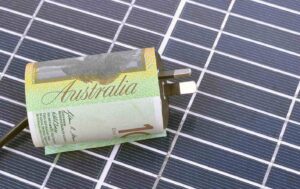A hot-water heat pump can be the cheapest way to heat water at your home or business. When matched with rooftop solar photo-voltaic (PV) electricity generation, hot-water heat pumps save even more.
Operating in a method similar to a reverse-cycle air conditioner in heating mode, a hot-water heat pump uses a refrigerant cycle to heat water by extracting free renewable heat from the air outside your home.
Globally, the International Energy Agency reports that accelerating sales of hot-water heat pumps and has identified these as a renewable-energy technology that is key to slowing climate disruption.
Buy one get four
For every one unit of electricity used, an efficient hot-water heat pump can add up to four units of heat to your water. “Buy one, get four” is one way to think about it.
Another is to think of is a 400 per cent efficient. Compare this with heating water via a resistive-electric hot water service (100% efficient) where it’s only “buy one get one”. Or worse yet, compare a heat pump with a gas-fired hot water service that might only be 75% efficient.
Because hot-water heat pumps collect free renewable heat from the air outside your home or business, the installation cost in Australia is reduced by the renewable energy credits on offer (the so-called STCs or small-scale renewable technology certificates).
Furthermore, in some states, territories or local council areas or with certain lenders additional rebates and incentives may apply. (Four examples presented above by the hyperlinks.)
Many brands to compare
These days in Australia, there are many hot water heat pumps among which to choose. To narrow it down a bit, we polled our members at My Efficient Electric Home, and can share a list of brands our members are happy with.
For some homes or businesses, replacing an existing hot water service with a cheaper-end hot-water heat pump might cost you from $500 to as little as $0 out of pocket installed. Or, at the other end of the cost/quality scale, for those that use greater volumes of water, it might make economic sense to opt for the most-efficient heat pumps (those that use supercritical carbon dioxide refrigerant).
Presumably due to limited supply competition in Australia, these top-quality devices can cost up to $4,500 out-of-pocket / installed.
A “thermal battery”
A hot-water heat pump stores hot water in a tank. This hot water can then be used 24 or even 48 hours later. In this way, a hot-water heat pump is a “thermal battery”, a clever way to capture energy and to then store that energy for later use.
Most hot-water heat pumps can be timed to use “off-peak” electricity, or to heat mid-day when rooftop solar PV is at peak production, and therefore providing the cheapest hot water possible.
What about roof-mounted solar thermal hot water?
Installing a solar-thermal hot water service (with the familiar rooftop heat-collecting panel) was formerly seen as a cost effective and environmentally-friendly thing to do. Unfortunately, in Australia’s colder or less sunny areas, these devices rely on gas or electric-resistive “boosting” for much of the year.
During winter months, some of the cheaper, poorly installed, or mal-functioning solar-thermal hot water services might lose more heat to the environment than they collect!
So, if your home relies on a solar-thermal hot water service, try to find out just how much gas or electric “boosting” is going on during the winter months. At the group My Efficient Electric Home we have had far too many reports about the shortcomings of this technology which has now, for many Australian locations, been superseded by superior hot water heat pumps.
And there’s another problem with solar-thermal hot water, the use of which can be required on new homes by out-dated government regulations.
A volume-home builder may rather lazily position the water-heating roof panel right in the middle of the best part of the roof, where the home owner would be better off having a large array of electricity-generating solar PV panels.
The hot-water heat pump is a key part of the efficient all-electric home
Future Australian homes will be all-electric. Studies have found there are thousands of dollars to be saved in your home by combining renewable heat and electricity for the key services of space heating, water heating, and cooking. The hot-water heat pump is part of that economic choice.
Next explainer: “The pot handles don’t even get hot”, and other advantages of the electric-induction cooktop.
See also:
Explainer: What’s the cheapest way to heat my house if I get off gas?
Explainer: How electric induction cookers work and why they clear the air
Explainer: How to cut home emissions and power bills by fixing leaks and insulation










